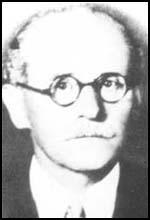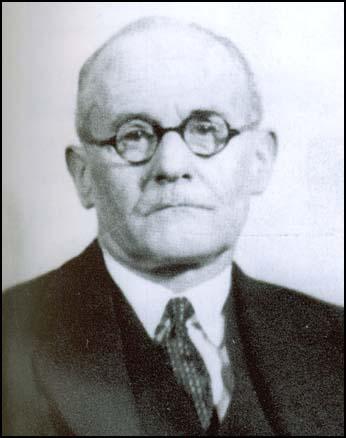Claude Dansey

Claude Edward Marjoribanks Dansey, the second child and eldest son in the family of four sons and five daughters of Edward Mashiter Dansey, was born in South Kensington on 10th September 1876. He was educated at Wellington College until 1891, when he was removed by his family as a result of a diphtheria epidemic.
Dansey went to a British boys' school in Bruges but he was removed after a homosexual scandal. According to Keith Jeffery, the author of MI6: The History of the Secret Intelligence Service (2010), Dansey was "seduced by Robbie Ross, who later became the lover of Oscar Wilde.
In 1895 Dansey went to the new colony of Rhodesia and joined the Matabeleland Regiment of the British South Africa police. He helped suppress the Matabele Uprising in 1896, and according to his biographer, M.R.D. Foot: "Dansey... learned the elements of scouting and intelligence gathering. In 1898 he returned to England and secured a militia commission in the Lancashire Fusiliers. Dansey spent ten weeks in the winter of 1899–1900 with the British North Borneo Company police force as a sub-commandant, in operations against Muhammad Salleh, before rejoining his regiment in South Africa in 1900."
Dansey also took part in the Relief of Mafeking, where he became friends with fellow-subaltern, Winston Churchill. He spent the rest of the war in the field intelligence department. In 1900 he received a regular commission as lieutenant in the 6th battalion of the Lancashire Fusiliers. He stayed in South Africa, on intelligence duties, until 1904, and then spent five years in British Somaliland as a political officer.
On his return to England he was recruited into the security branch of the secret service. He spent three years in New York State spying on wealthy Irish-Americans. In 1917 he helped to set up the first official American military intelligence service. After meeting Vernon Kell, during the First World War, Dansey, joined MI5. He was promoted lieutenant-colonel and took over SIS's organization in Switzerland.
As Christopher Andrew has pointed out, Mansfield Cumming, the head of MI6, had to reduce spending on the service after the war: "Like the rest of the British intelligence community, the post-war SIS was drastically cut back. Cumming succeeded, however, in gaining a monopoly of espionage and counter-intelligence outside Britain and the empire. He also established a network of SIS station commanders operating overseas under diplomatic cover." Dansey was one of those officers working under cover.
In 1929, Hugh Sinclair, the new head of MI6 employed Dansey under the cover of passport control officer, in Rome. According to M.R.D. Foot: "Dansey left Rome in 1936; word seeped out that he had been caught with his hand in the till and sacked. He settled into an export-import office in Bush House in the Strand, and set up parallel networks of secret intelligence agents to cover the penetrated areas, using the codename Z and avoiding the use of wireless."

According to Gill Bennett, the author of Churchill's Man of Mystery (2009): "In 1936 he (Hugh Sinclair) had set up Z Section, a UK-based agent running organisation under Claude Dansey with the aim of gathering intelligence from Germany and Italy on political and military matters. Z was kept quite separate from Headquarters, operating out of Bush House in London under cover of the export department of Geoffrey Duveen and Company. Dansey ran his own small staff, including Jewish emigres and other exiles, and supposedly communicated with SIS only through Sinclair, although the evidence suggests that Desmond Morton too received information directly from Dansey."
Dansey was not a popular figure in MI6. Anthony Read and David Fisher, the authors of Colonel Z: The Life and Times of a Master of Spies (1984), have argued that "though a successful and even brilliant intelligence officer, he was an unpopular figure within the SIS: one officer who worked with him described him as a trouble-maker, dishonest and a man of irrational dislikes".
After the death of Hugh Sinclair, Dansey became assistant chief to his friend Stewart Menzies, the new head of MI6. Richard Deacon, the author of Spyclopaedia (1987), described Dansey as "one of the worst choices for a senior executive of MI6". Dansey was placed in charge of all active espionage during the Second World War. He decided to merge the Z and SIS networks in Europe. However, with the arrests of Sigismund Payne Best and Richard Henry Stevens by the Gestapo on 9th November, 1939, SIS networks all over Europe were "broken in a single day". At the end of the war Dansey was persuaded to retire to Bathampton Manor.
Claude Dansey died in the Lansdown Grove Hospital, Bath, on 11th June 1947.
Primary Sources
(1) Keith Jeffery, MI6: The History of the Secret Intelligence Service (2010)
During the late summer of 1917 Freddie Browning started to work on a scheme to reorganise the Service, which he and Cumming discussed on 23 August with a new member of staff, Major Claude Marjoribanks Dansey. The forty-one-year-old Dansey, who came from a family of English country squires, had an unusually wide range of experience. As a youth he had been moved for health reasons from a conventional English public school (Wellington) to a British boys' school in Bruges, Belgium, and had been seduced by Robbie Ross (who later claimed to have been Oscar Wilde's first lover). Dansey went on to serve in the British South Africa Police during the Matabele Rebellion of 1896, as a colonial policemen fighting bandits in Borneo, and as a British army lieutenant in the South African War of 1899-1902. Between 1904 and 1909 he was a colonial political officer in Somaliland, after which he travelled in Africa and was later employed as resident secretary of a country club in upstate New York. When Dansey worked for Vernon Kell's organisation in the early years of the war, Cumming had had regular dealings (and lunches) with him, and the two men had discussed the possibility of Dansey coming to work for him, which he finally did on 20 August 1917.
(2) Gill Bennett, Churchill's Man of Mystery (2009)
Sinclair took a number of steps to try to ameliorate the situation and enable SIS to cope with the increasing demands placed upon it. In 1936 he had set up Z Section, a UK-based agent running organisation under Claude Dansey with the aim of gathering intelligence from Germany and Italy on political and military matters. Z was kept quite separate from Headquarters, operating out of Bush House in London under cover of the export department of Geoffrey Duveen and Company. Dansey ran his own small staff, including Jewish emigres and other exiles, and supposedly communicated with SIS only through Sinclair, although the evidence suggests that Desmond Morton too received information directly from Dansey.
(3) Richard Deacon, Spyclopaedia (1987)
One of the worst choices ever made for a senior executive of M16, Dansey became a deputy-chief of the British SIS before World War II largely on account of his World War I record. He had been stationed in Switzerland before the war and took a personal interest in intelligence from this territory. One worthwhile criticism he made was that everyone throughout the world knew that British Passport Control offices were the regional HQ of the Secret Service, so he successfully urged the creation of the "Z" network. The idea was good in that it was intended to act as a safeguard if the main SIS network was broken, but it depended upon having highly efficient agents, and Dansey's choices were not particularly good. There were therefore two British spy networks in Holland, one headed by Major Stevens and the other belonging to the "Z" network headed by Captain Payne Best. When World War II broke out it was decreed - foolishly, as it turned out - that the two networks all over the continent should merge. As a result, Best and Stevens were detected by German Intelligence, fed with disinformation and lured to Venlo on the Dutch-German border where they were kidnapped. Thus, two of Britain's key intelligence officers in Europe were made prisoners by the Nazi secret police. Too late did they learn that their German contact man, whom they knew as Schaemmel, was none other than Schellenberg of the Nazi Central Security Agency. As a result SIS networks all over Europe were decisively broken in a single day.
Dansey may have been unfairly blamed for what was basically a good idea, but his choice of agents left much to be desired. He was almost paranoiacally jealous of the Americans and was highly displeased when, later in the war, copies of documents a German brought with him from Berlin reached the SIS via the OSS in Washington. Foolishly, Dansey insisted the documents were fakes and had been planted on the Americans. However, the documents proved to be genuine and the Americans adopted the German agent, obtaining valuable intelligence from him. This slip-up marked the end of Dansey's career.
